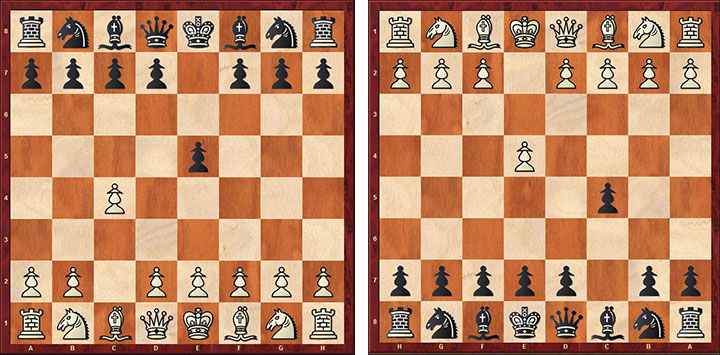.jpeg)

.jpeg)
As an Italian transplant in Georgia (the state not the country), I didn't know the word 'bombastic', I went looking for it in the dictionary and discovered it came from the Latin word for cotton (bombax), or any kind of padding material. It seems, in turn, to have derived from the older Latin / ancient Greek word: "Bombyx" which meant silkworm or silk. And here we can relate the word used in the title of this new video series which runs "smooth like silk".
 Coming back from this etymological trip, to the opening named after British Master Henry Bird (pictured)... I learned to play Bird's because of another bombastic chap: GM Simon Williams. He is a fanatic Classical Dutch player, sometimes going into a Stonewall Dutch depending on the needs of the position.
Coming back from this etymological trip, to the opening named after British Master Henry Bird (pictured)... I learned to play Bird's because of another bombastic chap: GM Simon Williams. He is a fanatic Classical Dutch player, sometimes going into a Stonewall Dutch depending on the needs of the position.
There is a reverse-connection between the openings one can play as Black, with the one played as White. The most famous is the English which after 1.c4 e5 is a reversed Sicilian.
The same goes for other openings we play as Black which can also be played as White, in this case, we have Bird's opening and the Dutch respectively. In fact, Bird's opening is sometimes referred to as "the Dutch attack".

1.c4 e5 and 1.e4 c5

1.f4 d5 and 1.d4 f5
Bird's is a flexible opening, which also can transpose to lines in the Nimzo-Larsen attack, since depending on the move order, we can see such magnificent metamorphoses. It certainly helps keep our opponents off balance. For example: 1.b3 e5 2.Bb2 Nc6 3.e3 d5 4.Bb5 Bd6 5.f4 is one of these transpositions between these two openings.
A big difference between Black and White is whose turn to move. With Black, we need to wait, while with White we gain a tempo which we can use to attack.
Trent begins by telling us he has played Bird's himself on a few occasions. Thanks to Megabase 2019, I quickly recovered all his games with the opening and reviewed them. I found his games full of energy and fireworks. Here are a few of them:
Before you dismiss his games played with the Bird's opening as those of 'just' and IM, with Mega we can also immediately spot the number of times the World Champion, Magnus Carlsen, has used the Bird's — four times it turns out — and with positive results: Four wins!
Hikaru Nakamura, previously one of the top ten players in the world, who seems more dedicated to the financial markets of late, has used Bird's extensively, albeit not with quite as good results as the World Champion:
At any rate, I was happy Trent created this video series because as an adult with lots of other responsibilities, my chess studies are quite erratic. One week I have time to dedicate a healthy number of hours, and the next I cannot spare much time at all. Thanks to Trent, I can instead have all the material in one neat package, specially stacked with all the latest theoretical discoveries.
As with the Dutch after 1.d4 f5 we can have a gambit with 2.e4, and the same applies to Bird's. We must be prepared! The From's gambit is 1.f4 e5 and here with White so we can actually take with 2.fxe5, when Black generally continues with 2...d6:
As in my previous review on the Classical Dutch, made by GM Pert, I must caution the reader to take From's Gambit (like the Staunton Gambit for the Classical Dutch) very seriously. As we can see, Mr Bird himself paid the price for being unprepared more than once against From's gambit:
Like the Staunton's Gambit, I expect the following criticism: "but in that time they didn't have the great defensive technique we have today and didn't study with engines." Well check White's rating, and decide for yourself if it is safer to deeply study how to neutralize From's gambit. (Notice in the sample I've included some games by GM Danielsen, a leading expert in Bird's Opening.)
Trent for his part takes From's Gambit quite seriously, because he dedicated an entire section to it, with five videos. And he worked very hard to come up with a new concept for fighting the gambit. As someone who has played Bird's in a tournament and also in matches, I wish I had Trent's knowledge beforehand. It would have saved me many points. Just the section on From's Gambit justifies the price of the DVD in my opinion.
Trent also mentioned one other important point, in case From's Gambit is not your cup of tea. After 1.f4 e5 if White plays 2.e4 he enters the King's Gambit. ChessBase has a pair of video series authored by GM Williams, who will teach everyone how to play the King's Gambit successfully. This is worth considering because it could bring the opponent totally out of his theoretical preparation if he just knows about From's but is not a habitual 1...e5 player.
But the real novelty of this DVD is something which I believe was missing for those who, like me, love to watch videos. Trent is actually presenting a Bird's-Leningrad repertoire, after the moves: 1.f4 d5 2.Nf3 Nf6 3.g3
The name is a reference to the Leningrad Dutch which we have after the moves:
1.d4 f5 2.c4 Nf6 3.g3 g6 4.Bg2 Bg7 5.Nf3
The Leningrad was previously treated in two other ChessBase video series:
Obviously, if one learns to play it as Black, this Leningrad-ish Bird's Opening as White will come naturally — one just has an extra tempo.
After the introduction video, the first section is dedicated to rare lines. It is made up of seven videos, in which Trent definitely did the homework for us, finding the strangest replies, and giving us the tools we need to neutralize them.
I never encountered many of these lines in tournament games, but enjoyed being exposed to material I didn't know, which will make me more prepared for future tournament games. I found Trent's description of the Hobbs gambit funny:
"To put it delicately, the move g7-g5 is garbage"
Now if the Hobbs Gambit is garbage, considering the number of people who lost with White, I think one must nevertheless be prepared. Here are few games Carlsen's second Peter Heine Nielsen won, but the other players were swallowed up by the 'garbage'.
That's enough for the sample of games — I think the best would be to have Megabase 2019, and through the weekly updates to the over 7 million games, one can make a search for each line, and check as many games as possible to discover what works and what doesn't.
The video series is accompanied by a custom database of 144 model games, and Trent annotates many of these games in the videos. After watching the videos, an ambitious student could annotate the games and see what he or she remembers from Trent's analysis. Then it would be quite useful to watch the video again and see what was missed or forgotten.
Trent, throughout the series, gives improvements to the moves played in actual games, like the following position which comes from a game I showed above.
Trent says White should play 8.Qb3 (Nielsen played 8.Be2) and you can play it directly in the diagram above against the engine. Another way to use the video series is to play lines like this one against Fritz. I gave the move/improvement by Trent, but in the video he follows up to move 12 and then gives an evaluation, and possible plans for White.
Trent doesn't really treat the move 1...c5 with the idea to play a Sicilian. However in the section dedicated to 1.f4 d6 Trent goes over some lines which transpose into the Grand Prix Attack, for example, 1.f4 d6 2.e4 c5
His suggestion, for those who would like to learn about the Grand Prix, is to get his ChessBase DVD, which covers it quite well.
Trent treats some pawn structures which are similar to the Sicilian, for example in the section Fianchetto and e6 he shows how White deals when Black plays e6 d5 c5, for example after the moves 1.f4 d5 2.Nf3 Nf6 3.g3 e6 4.Bg2 c5
White continues castling kingside, and then Black has many options, all covered deeply by Trent.
There are also other lines, explained by Trent, which clearly seems coming from Sicilian structures, like the following: 1.f4 g6 2.Nf3 Bg7 3. g3 c5 4.Bg2 d6 5.0-0 Nc6 and here Trent would continue with 6.d3. Trent says this would transpose into the lines with d5 and he deals with them more in that section.
Trent has unearthed a lot of significant theoretical improvements which are worth studying. ChessBase's training system unites the best of two worlds: books and videos. In this DVD there are 144 games, which one can use for replay training — the new feature introduced with ChessBase 15 (the best training for learning a new opening). This dovetails nicely with videos and interactive training. Then, of course, one must follow up with practice, such as online blitz games, and moving on to play in tournaments with long time control games. Trent did his part and delivered on his promises. He promised he would prepare us against From's Gambit, and he covered all the lines of this tricky attempt at a refutation to Bird's Opening. Then, of course, there is the main repertoire, which is a new way to play Bird's, compared to the way I played it before (as a reverse Classical Dutch).
While I consider 1.f4 a good opening, and I have used it a lot in tournaments with good results, I don't advise it for beginners or players who are not able to recognize transpositions into other openings. For example, while working on this review I happened to see some games by the legendary Bobby Fischer and also GMs like Davies who, when playing against the Sicilian or the French, use the King's Indian Attack, entered by transposition into what we could call the Bird's (but not playing f4 as the first move and instead much later in the game). The point is: the ideas we can get from those games can be applied to Bird's, we just need to be flexible enough to see how to incorporate pattern (e.g. related to a knight or other piece manoeuvres) into our own 1.f4 games. My fear is that someone around 1500-1700 doesn't understand nuances to handle the opening correctly. So my advice would be to begin studying the Dutch, and then after practising a little over the board with the Dutch, begin to learn Bird's.
Trent's series on the Grand Prix Attack, explains many attacking themes on the kingside. Those ideas and patterns can be applied both to the Classical Dutch and the Bird's. One last thing: I'm quite happy ChessBase made this DVD. It's really great fun, and I love Trent's presentation style. He is quite pragmatic and focuses on important points we need to remember.